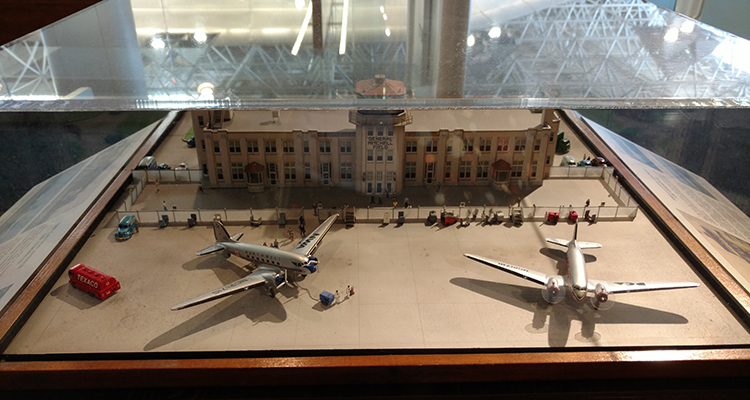Times are good for General Mitchell International Airport. In June, Allegiant Air added five nonstop flights from the Milwaukee County airport; a week later, Milwaukee County Executive Chris Abele announced passenger traffic had increased 1.2% from May 2016 to May 2017, and nearly 10% compared to the previous month. Not bad for a place sometimes known as Chicago’s “third airport,” and named after a man who was kind of a pain in the ass.
The history of Mitchell—and of air travel in Milwaukee—dates back to July 3, 1919, when the Milwaukee County Park Commission opened the county’s first airfield at what is now the Currie Park Golf Course. This so-called Butler Airport was humble, but it did have one claim to fame: it was home to the famed Lawson Airliner, a.k.a. America’s first commercial aircraft. The airliner departed on a history-making demonstration flight to the east coast on August 27, 1919. The twin-engine, 16-passenger craft made stops in New York City and Washington, D.C. before returning to Butler Airport on November 15.
With airmail service booming (and beginning in Milwaukee on June 7, 1926, via the Charles Dickinson Line), the county soon realized that Butler Airport was too small. A railroad line to the west and a river to the east made necessary expansions impossible. So, in October 1926, the Milwaukee County Board approved a cool $150,000 to purchase a 162-acre lot a mile west of Cudahy called Hamilton Field (named after local aviator and propeller manufacturer Thomas Hamilton). Butler Airport was shuttered a month later, and all aviation activity moved to the newly minted Hamilton Airport.
Which brings us to Milwaukee County’s first passenger airline flight. The Hirschbuehl Farmhouse, a.k.a. Hamilton Airport’s first terminal, opened in July 1927. On the 5th of July, Northwest Airlines, Inc. launched passenger service from Milwaukee to Chicago and Minneapolis/St. Paul. The first flight wasn’t without peril, however. Per the Milwaukee Journal Sentinel:
The first passengers landed at Milwaukee County Airport (now Mitchell International Airport) courtesy of Northwest Airlines. Before it got here, the flight was forced down by engine trouble about 30 minutes out and had to return to St. Paul before trying again.
A historical marker sums up the entire story:
On October 29, 1926, Milwaukee County purchased the flying field which Thomas Hamilton had established in 1920 on East Layton Avenue in connection with his propeller business. Northwest Airways inaugurated scheduled passenger service here on July 5, 1927, and that year Hamilton began production of an all metal passenger transport plane adopted by many early airlines.
Kohler Aviation Corporation provided the missing link in Milwaukee’s air network by initiating passenger service across Lake Michigan to Grand Rapids and Detroit on August 31, 1929. Such famous pioneer fliers as Charles A. Lindbergh, Lester Maitland, the Bremen fliers, Wiley Post, and Eddie Rickenbacker visited this field.
On March 17, 1941, this airport was renamed in honor of General William Mitchell (1879-1936), Milwaukee’s famous air power advocate who had also proposed a strong civil aviation as part of the nation’s defense.
Finally, in a 2016 piece on General Mitchell International Airport’s curious “Gallery of Flight,” Milwaukee Record contributor Monica Reida concludes:
I never would have anticipated this nondescript place I’ve routinely walked past on my way from the ticket counter to the security line would actually end up being pretty interesting. Of course, you have to go to the airport to see it. This seems like a bit of a hassle to warrant another visit for that reason alone, but I made a note that the next time I’m at the airport waiting for my flight, maybe I would pop into the Mitchell Gallery of Flight and read more on Milwaukeeans and their contributions to aviation history. Maybe you should, too, or risk killing another hour at Chili’s Too.

